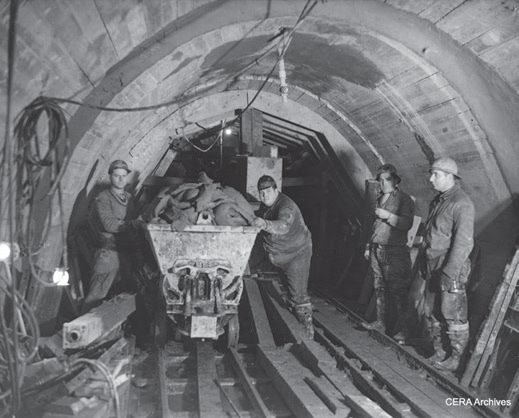The underground tunnel
Rachel Fowler, Associate Editor | TLT Lubrication November 2015
How my grandfather lubricated locomotives beneath Chicago’s Loop during World War II.

Workmen in 1939 in the Chicago tunnels excavate clay as they work on the Chicago Subway. (Photo courtesy of the Central Electric Railfans’ Association archives.)
MANY OF YOU MIGHT NOT KNOW WHAT'S UNDERNEATH THE STREETS OF CHICAGO, but there’s a whole history not talked about much these days.
I recently visited my grandfather, John Kacich of Berkeley, Ill., and we celebrated his 88th birthday. He was born in 1927 in Chicago. He’s a humble man who doesn’t talk about himself much, but I had the pleasure of hearing some of his fascinating stories on his birthday.
In Chicago in the early 1900s, a series of underground tunnels were built all over the Chicago Loop that stretched about 55 miles. The original plan was to fill the tunnels with phone cables, but eventually they were used for transporting goods between railroads.
John started working for the Chicago Tunnel Co. in 1943 when he was 16 years old. He worked there on and off for about five years. His father worked for the company, so John decided to get a job there during summers when school was out. At that time, they were using the tunnels for transporting smaller goods like candy, musical instruments, miniature trains, peanuts, etc. He started out in the general office and eventually moved up to work in the tunnel.
“The tunnel was a constant 55 degrees in winter and summer,” says John. “When leaving work, if it was really hot out, it would really knock you out when you got on the streetcar. I’d oversleep my stop a lot of times when I was coming home.” This constant temperature also would provide coolness to buildings in the area before air conditioning.
One of John’s first jobs after leaving the general office was in the roundhouse, which is a building with a track that would swivel. It has a semicircular shape for regular locomotives, but was rectangular in the tunnels. Different tracks would come in, and one main track would travel back and forth so a locomotive could be pulled. It could hold more than 10 locomotives in a smaller area. In the roundhouse, John would repair the locomotives and fix little wrecks that happened along the way. After a while, John started working in the shop. He also repaired the locomotives there.
The locomotive had two sources of power: one electric motor in the back and one in the front. “Usually if one of the motors gave out, you had the other one,” says John. “So you could come in on one. If you got a call for a repair job, you’d take a good locomotive out to him and take the bad one back. You wouldn’t have to pull anything since it could come in on one motor.”
Around this time, the Chicago Subway also was working underground. That project required excavating mud, sand and whatever was underground, and the Chicago Tunnel Co. got the job of carrying all of this out of the work area and bringing it up to the streets. This gave Chicago more land for the lakefront. Also, a lot of the downtown buildings were coal-fired. As another side job, the Chicago Tunnel Co. removed the cinders and ashes so the job wouldn’t require adding trucks on the streets. One of the main functions of the tunnel was to keep more traffic off the streets.
One of John’s other jobs was oiling the locomotives and making sure they were well-lubricated. “It was just one night a week when I’d do the oiling and greasing, which would be Sunday,” he says. “I’d be the only one down there, and it never dawned on me to be afraid about it or anything. Evidently I wasn’t claustrophobic.” Also related, the different cars that hauled ashes had a journal box on them. There was an axle in the journal box, and below the axle was the grease and oil. They applied grease using cotton waste, and oil was put in there to constantly lubricate the axle as it was turning.
John used an oil called Slo Flo. “I don’t know if it was a trade name, but its viscosity was more than the normal oil,” he says. “It was thick and would flow very slowly. We used that almost exclusively along with that cotton waste to lubricate the axles on the boxcars.”
Most days John worked on motor repair or with the wrecking crew. “When a car would jump the tracks, usually the wheels that held the car on the tracks would come apart,” says John. “You’d have to jack the boxcar up and put the wheels together in proper alignment. Then you’d have to put the whole thing back together again to keep freight moving.”
John took his work seriously, but he was a teenager at the time. “I took a friend down there once to show him what it was like,” he says. “I put him on the front of a locomotive and we went all around the tunnel.”
Even into adulthood I’m learning amazing things about my grandpa.
 You can reach TLT associate editor Rachel Fowler at rfowler@stle.org
You can reach TLT associate editor Rachel Fowler at rfowler@stle.org.